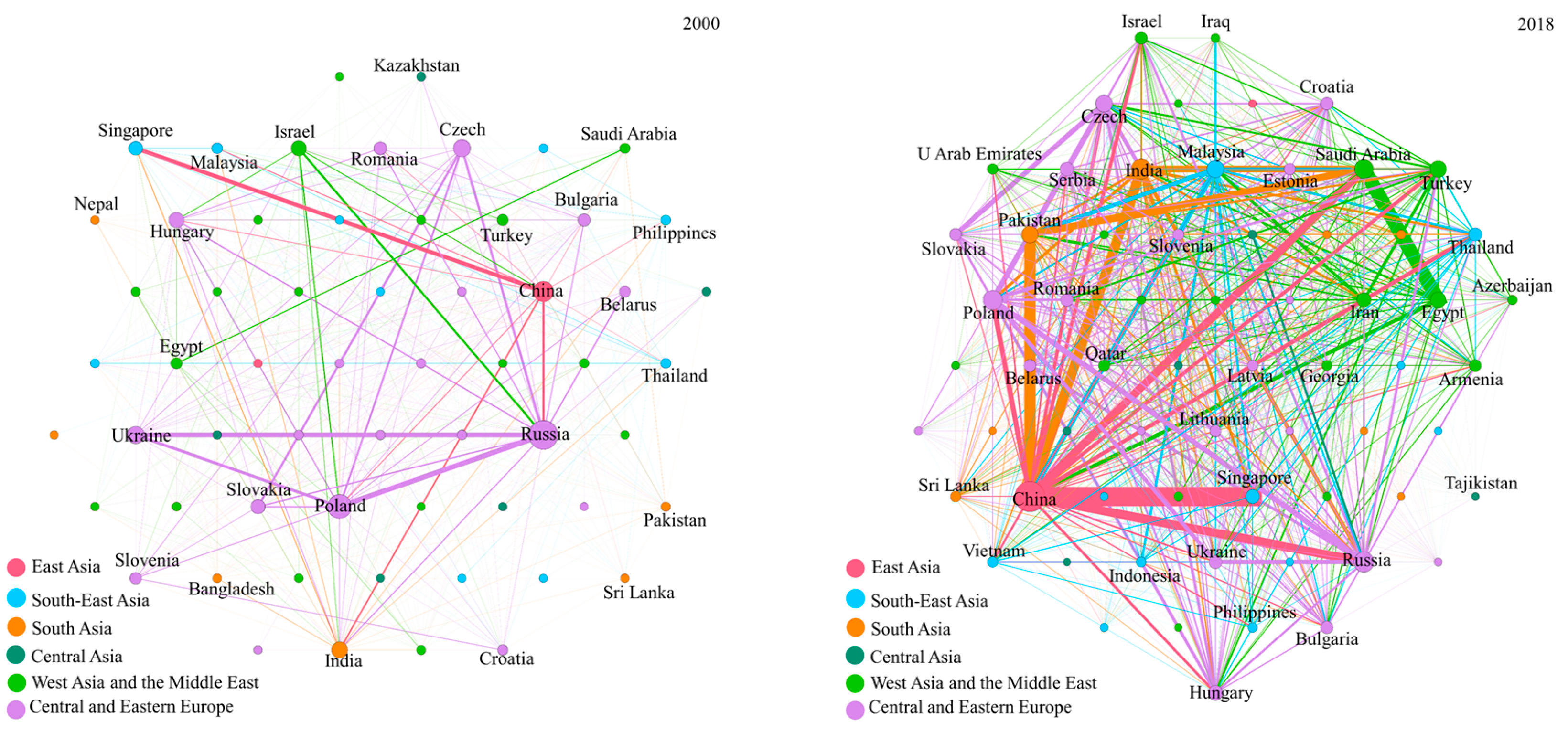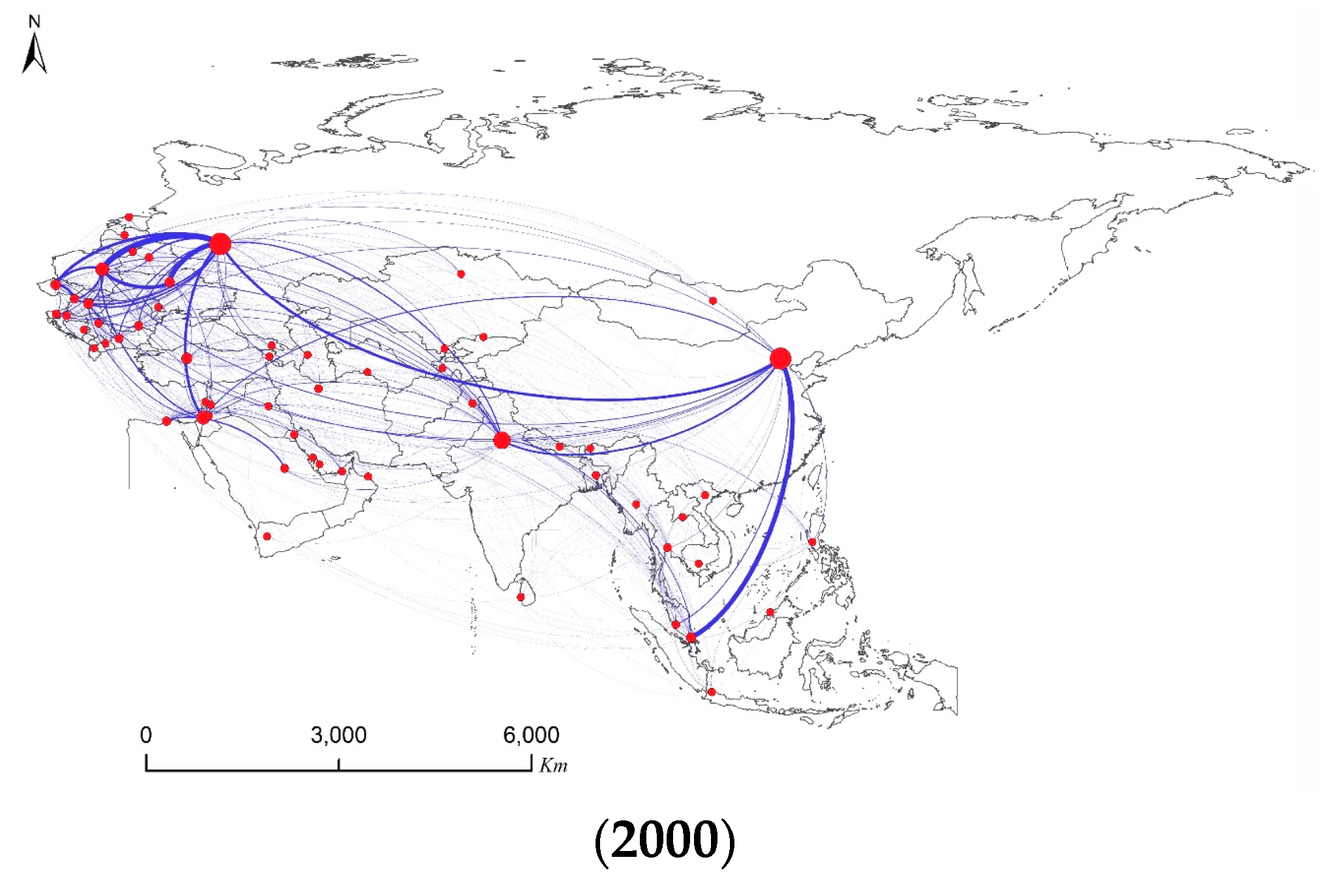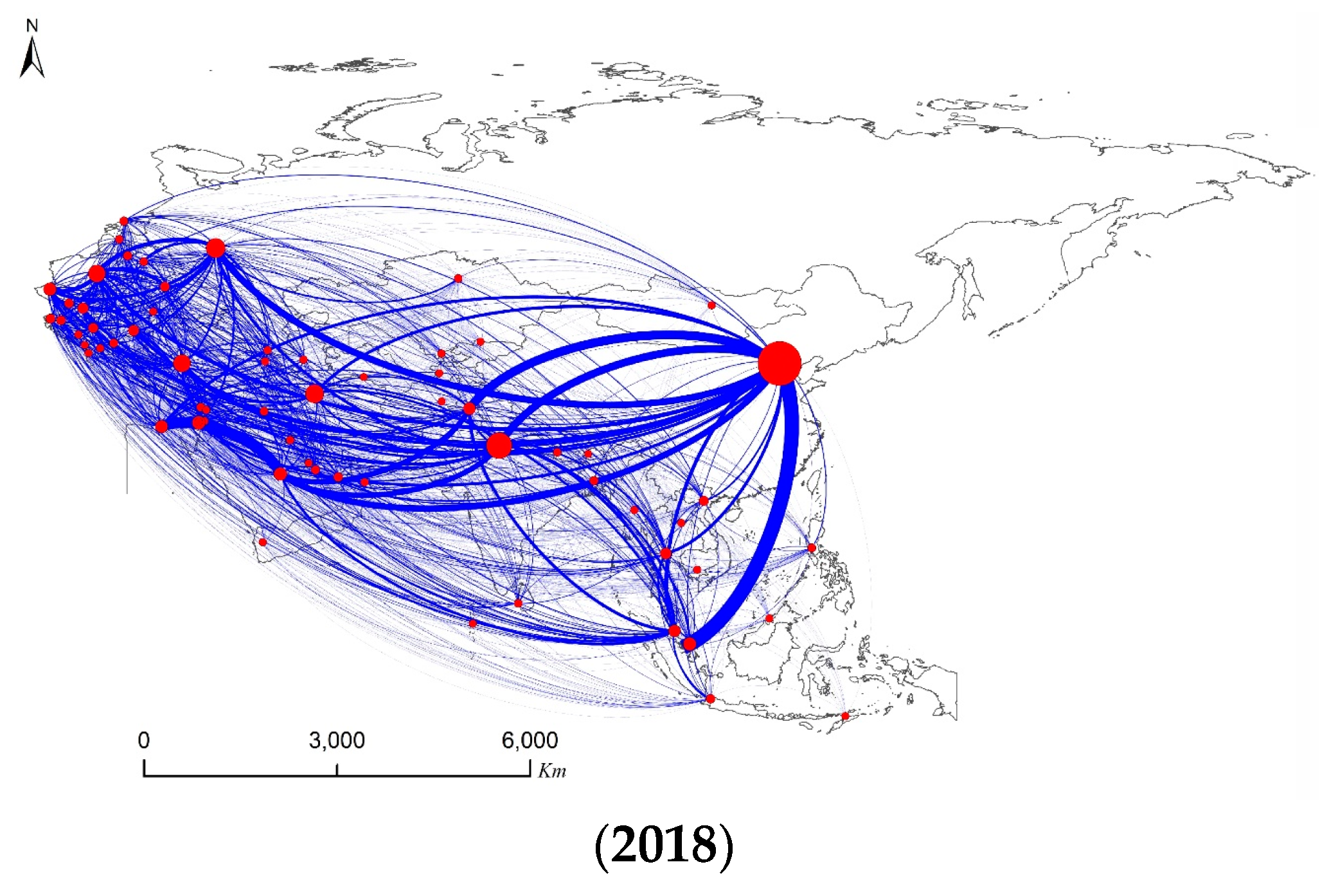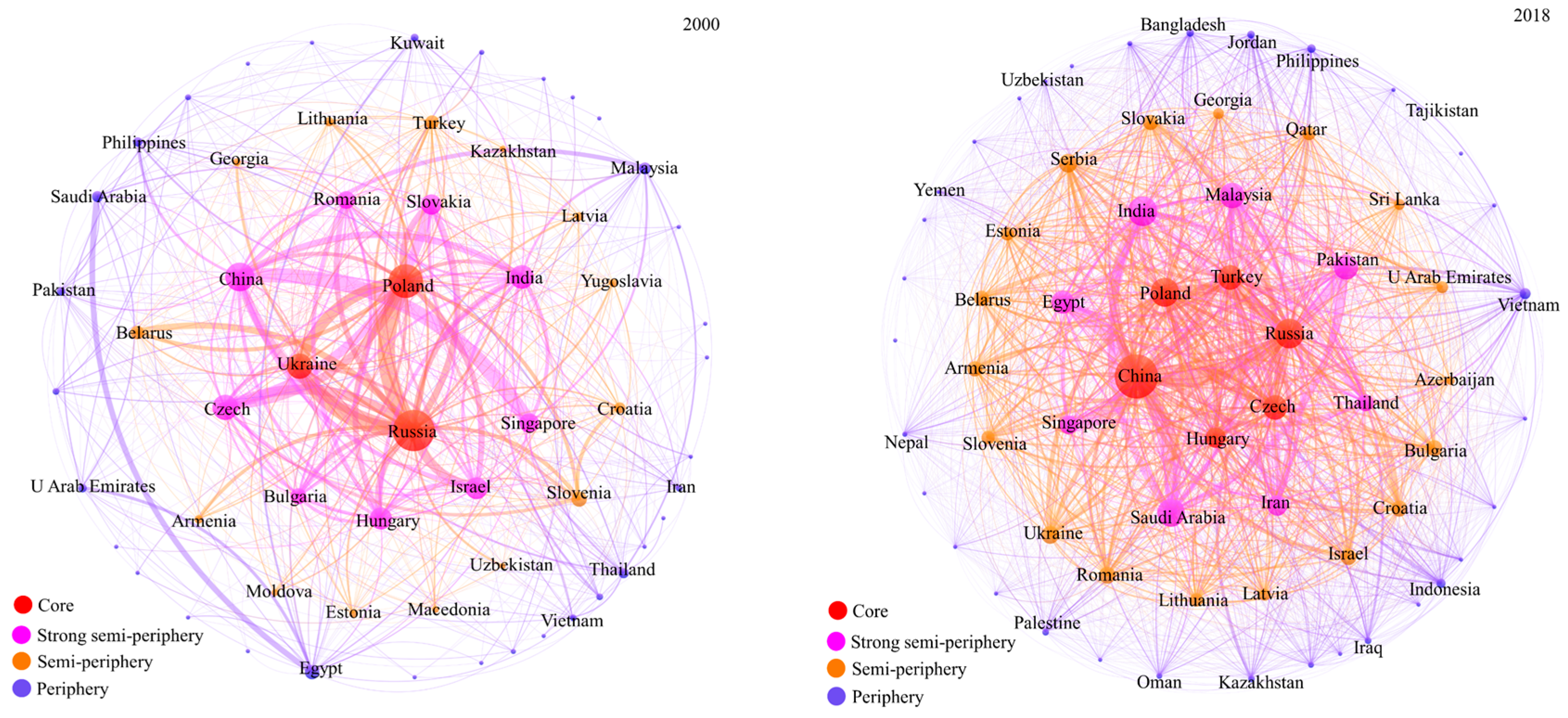The Structure and Dynamic of Scientific Collaboration Network among Countries along the Belt and Road
Abstract
:1. Introduction
2. Literature Review
2.1. Science and Sustainable Belt and Road
2.2. International Scientific Collaboration
3. Data and Methods
3.1. Research Area
3.2. Research Data
3.3. Social Network Analysis
3.3.1. Centrality Measure
3.3.2. Core and Periphery Analysis
3.3.3. Dominant Flow Analysis
4. Results
4.1. Network Statistics
4.2. Topology Structure
4.3. Spatial Pattern
4.4. Position of Countries
4.5. Core-Periphery Structure
4.6. Hierarchy of Countries
5. Discussion
Author Contributions
Funding
Acknowledgments
Conflicts of Interest
References
- Shen, S.; Chan, W. A comparative study of the Belt and Road Initiative and the Marshall plan. Palgrave Commun. 2018, 4, 32. [Google Scholar] [CrossRef]
- National Development and Reform Commission, Vision and Actions on Jointly Building Silk Road Economic Belt and 21st-Century Maritime Silk Road. 2015. Available online: http://en.ndrc.gov.cn/newsrelease/201503/t20150330669367.html (accessed on 15 June 2019).
- Chin, H.; He, W. The Belt and Road Initiative: 65 Countries and Beyond. 2016. Available online: https://www.fbicgroup.com/sites/default/files/B&R_Initiative_65_Countries_and_Beyond.pdf (accessed on 20 June 2017).
- Masood, E. All roads lead to China. Nature 2019, 569, 20–23. [Google Scholar] [CrossRef]
- Li, P.Y.; Qian, H.; Howard, K.W.F.; Wu, J.H. Building a new and sustainable “Silk Road economic belt”. Environ. Earth Sci. 2015, 74, 7267–7270. [Google Scholar] [CrossRef]
- Chen, Q.; Cheng, J.Q.; Wu, Z.Q. Evolution of the cultural trade network in “the Belt and Road” region: Implication for global cultural sustainability. Available online: https://www.mdpi.com/2071-1050/11/10/2744 (accessed on 22 September 2019).
- Rauf, A.; Liu, X.X.; Amin, W.; Ozturk, I.; Rehman, O.U.; Hafeez, M. Testing EKC hypothesis with energy and sustainable development challenges: A fresh evidence from belt and road initiative economies. Environ. Sci. Pollut. Res. 2018, 25, 32066–32080. [Google Scholar] [CrossRef]
- Horvat, M.; Gong, P. Science support for Belt and Road. Science 2019, 364, 513. [Google Scholar] [CrossRef]
- Jia, H.P.; Guo, H.D. Scientific collaborations shine on Belt and Road. Natl. Sci. Rev. 2017, 4, 652–657. [Google Scholar] [CrossRef] [Green Version]
- Ferdinand, P. Westward ho-the China dream and “one belt, one road”: Chinese foreign policy under Xi Jinping. Int. Aff. 2016, 92, 941–957. [Google Scholar] [CrossRef]
- Wang, Y. Offensive for defensive: The belt and road initiative and China’s new grand strategy. Pac. Rev. 2016, 29, 455–463. [Google Scholar] [CrossRef]
- Zhou, W.F.; Esteban, M. Beyond balancing: China’s approach towards the Belt and Road Initiative. J. Contemp. China 2018, 27, 487–501. [Google Scholar] [CrossRef]
- Du, J.L.; Zhang, Y.F. Does One Belt One Road initiative promote Chinese overseas direct investment? China Econ. Rev. 2018, 47, 189–205. [Google Scholar] [CrossRef]
- Liu, H.Y.; Tang, Y.K.; Chen, X.L.; Poznanska, J. The determinants of Chinese outward FDI in countries along “One Belt One Road”. Emerg. Mark. Financ. Trade 2017, 53, 1374–1387. [Google Scholar] [CrossRef]
- Liu, W.D.; Dunford, M. Inclusive globalization: Unpacking China’s Belt and Road Initiative. Area Dev. Policy 2016, 1, 323–340. [Google Scholar] [CrossRef]
- Dunford, M.; Liu, W.D. Chinese perspectives on the Belt and Road Initiative. Camb. J. Reg. Econ. Soc. 2019, 12, 145–165. [Google Scholar] [CrossRef]
- Huang, Y.P. Understanding China’s Belt & Road Initiative: Motivation, framework and assessment. China Econ. Rev. 2016, 40, 314–321. [Google Scholar]
- Duan, F.; Ji, Q.; Liu, B.Y.; Fan, Y. Energy investment risk assessment for nations along China’s Belt & Road Initiative. J. Clean. Prod. 2018, 170, 535–547. [Google Scholar]
- Wang, L.H.; Zheng, Y.B.; Ducruet, C.; Zhang, F. Investment strategy of Chinese terminal operators along the “21st-Century Maritime Silk Road”. Available online: https://www.mdpi.com/2071-1050/11/7/2066 (accessed on 22 September 2019).
- Lee, P.T.W.; Hu, Z.H.; Lee, S.J.; Choi, K.S.; Shin, S.H. Research trends and agenda on the Belt and Road (B&R) initiative with a focus on maritime transport. Marit. Policy Manag. 2018, 45, 282–300. [Google Scholar]
- Wang, L.H.; Zhu, Y.; Ducruet, C.; Bunel, M.; Lau, Y.Y. From hierarchy to networking: The evolution of the “twenty-first-century Maritime Silk Road” container shipping system. Transp. Rev. 2018, 38, 416–435. [Google Scholar] [CrossRef]
- Tracy, E.F.; Shvarts, E.; Simonov, E.; Babenko, M. China’s new Eurasian ambitions: The environmental risks of the Silk Road Economic Belt. Eurasian Geogr. Econ. 2017, 58, 56–88. [Google Scholar] [CrossRef]
- Ascensao, F.; Fahrig, L.; Clevenger, A.P.; Corlett, R.T.; Jaeger, J.A.G.; Laurance, W.F.; Pereira, H.M. Environmental challenges for the Belt and Road Initiative. Nat. Sustain. 2018, 1, 206–209. [Google Scholar] [CrossRef]
- Lechner, A.M.; Chan, F.K.S.; Campos-Arceiz, A. Biodiversity conservation should be a core value of China’s Belt and Road Initiative. Nat. Ecol. Evol. 2018, 2, 408–409. [Google Scholar] [CrossRef]
- Shi, K.F.; Yu, B.L.; Huang, C.; Wu, J.P.; Sun, X.F. Exploring spatiotemporal patterns of electric power consumption in countries along the Belt and Road. Energy 2018, 150, 847–859. [Google Scholar] [CrossRef]
- Liu, Y.Y.; Hao, Y. The dynamic links between CO2 emissions, energy consumption and economic development in the countries along “the Belt and Road”. Sci. Total Environ. 2018, 645, 674–683. [Google Scholar] [CrossRef] [PubMed]
- Howard, K.W.F.; Howard, K.K. The new “Silk Road Economic Belt” as a threat to the sustainable management of Central Asia’s transboundary water resources. Environ. Earth Sci. 2016, 75, 976. [Google Scholar] [CrossRef]
- Chen, M.X.; Sui, Y.W.; Liu, W.D.; Liu, H.; Huang, Y.H. Urbanization patterns and poverty reduction: A new perspective to explore the countries along the Belt and Road. Habitat Int. 2019, 84, 1–14. [Google Scholar] [CrossRef]
- Liu, C.L.; Xu, J.Q.; Zhang, H. Competitiveness or complementarity? A dynamic network analysis of international agri-trade along the Belt and Road. Appl. Spatial Anal. 2019, 1–26. [Google Scholar] [CrossRef]
- Zhang, Y.; Zhang, J.H.; Tian, Q.; Liu, Z.H.; Zhang, H.L. Virtual water trade of agricultural products: A new perspective to explore the Belt and Road. Sci. Total Environ. 2018, 622, 988–996. [Google Scholar] [CrossRef]
- Freeman, R.B. Globalization of scientific and engineering talent: International mobility of students, workers, and ideas and the world economy. Econ. Innov. New Technol. 2010, 19, 393–406. [Google Scholar] [CrossRef]
- Adams, J. The fourth age of research. Nature 2013, 497, 557–560. [Google Scholar] [CrossRef]
- Royal Society. Knowledge, Networks and Nations: Global Scientific Collaboration in the 21st Century; The Royal Society: London, UK, 2011. [Google Scholar]
- Marshall, A. Principles of Economics, 8th ed.; Macmillan: London, UK, 1890. [Google Scholar]
- Guo, H.D.; Liu, J.; Qiu, Y.B.; Menenti, M.; Chen, F.; Uhlir, P.F.; Zhang, L.; van Genderen, J.; Liang, D.; Natarajan, I.; et al. The Digital Belt and Road program in support of regional sustainability. Int. J. Digit. Earth 2018, 11, 657–669. [Google Scholar] [CrossRef]
- World Wildlife Fund. Available online: https://go.nature.com/2v3SwoG (accessed on 23 May 2018).
- Guo, H.D. Steps to the digital Silk Road. Nature 2018, 554, 25–27. [Google Scholar]
- Niosi, J.; Bellon, B. The global interdependence of national innovation systems-Evidence, limits, and implications. Technol. Soc. 1994, 16, 173–197. [Google Scholar] [CrossRef]
- Rosenberg, N. Inside the Black Box: Technology and Economics; Cambridge University Press: Cambridge, UK, 1982. [Google Scholar]
- Chesbrough, H.W. Open Innovation: The New Imperative for Creating and Profiting from Technology; Harvard Business School Press: Cambridge, MA, USA, 2003. [Google Scholar]
- Adams, J.; Loach, T. A well-connected world. Nature 2015, 527, S58–S59. [Google Scholar] [CrossRef]
- Nam, Y.; Barnett, G.A. Globalization of technology: Network analysis of global patents and trademarks. Technol. Soc. Chang. 2011, 78, 1471–1485. [Google Scholar] [CrossRef]
- Leydesdorff, L.; Wagner, C.S.; Park, H.W.; Adams, J. International collaboration in science: The global map and the network. arXiv 2013, 22, 87–94. [Google Scholar] [CrossRef]
- De Prato, G.; Nepelski, D. Global technological collaboration network: Network analysis of international co-inventions. J. Technol. Transf. 2014, 39, 358–375. [Google Scholar] [CrossRef]
- Wagner, C.S.; Leydesdorff, L. Network structure, self-organization, and the growth of international collaboration in science. Res. Policy 2005, 34, 1608–1618. [Google Scholar] [CrossRef] [Green Version]
- Gui, Q.C.; Liu, C.L.; Du, D.B. Globalization of science and international scientific collaboration: A network perspective. Geoforum 2019, 105, 1–12. [Google Scholar] [CrossRef]
- Leydesdorff, L.; Wagner, C.S. International collaboration in science and the formation of a core group. J. Informetr. 2008, 2, 317–325. [Google Scholar] [CrossRef] [Green Version]
- Chen, Z.F.; Guan, J.C. The core-peripheral structure of international knowledge flows: Evidence from patent citation data. RD Manag. 2016, 46, 62–79. [Google Scholar] [CrossRef]
- Fleming, L.; King, C.; Juda, A. Small worlds and regional innovation. Organ. Sci. 2007, 18, 938–954. [Google Scholar] [CrossRef]
- Zhang, G.P.; Guan, J.C.; Liu, X.L. The impact of small world on patent productivity in China. Scientometrics 2014, 98, 945–960. [Google Scholar] [CrossRef]
- Guan, J.C.; Zuo, K.R.; Chen, K.H.; Yam, R.C.M. Does country-level R&D efficiency benefit from the collaboration network structure? Res. Policy 2016, 45, 770–784. [Google Scholar]
- Borgatti, S.P.; Mehra, A.; Brass, D.J.; Labianca, G. Network Analysis in the Social Sciences. Science 2009, 323, 892–895. [Google Scholar] [CrossRef] [Green Version]
- Chen, Z.F.; Guan, J.C. The impact of small world on innovation: An empirical study of 16 countries. J. Informetr. 2010, 4, 97–106. [Google Scholar] [CrossRef]
- Gui, Q.C.; Liu, C.L.; Du, D.B. Does network position foster knowledge production? Evidence from international scientific collaboration network. Growth Chang. 2018, 49, 594–611. [Google Scholar] [CrossRef]
- Plotnikova, T.; Rake, B. Collaboration in pharmaceutical research: Exploration of country-level determinants. Scientometrics 2014, 98, 1173–1202. [Google Scholar] [CrossRef]
- Montobbio, F.; Sterzi, V. The globalization of technology in emerging markets: A gravity model on the determinants of international patent collaborations. World Dev. 2013, 44, 281–299. [Google Scholar] [CrossRef]
- Gui, Q.; Liu, C.; Du, D. International Knowledge Flows and the Role of Proximity. Growth Chang. 2018, 49, 532–547. [Google Scholar] [CrossRef]
- Cassi, L.; Morrison, A.; Rabellotti, R. Proximity and scientific collaboration: Evidence from the global wine industry. Tijdschr. Voor Econ. Soc. Geogr. 2015, 106, 205–219. [Google Scholar] [CrossRef]
- Orazbayev, S. International knowledge flows and the administrative barriers to mobility. Res. Policy 2017, 46, 1655–1665. [Google Scholar] [CrossRef] [Green Version]
- Cantner, U.; Rake, B. International research networks in pharmaceuticals: Structure and dynamics. Res. Policy 2014, 43, 333–348. [Google Scholar] [CrossRef] [Green Version]
- Freeman, L.C. Centrality in social networks conceptual clarification. Soc. Netw. 1978, 1, 215–239. [Google Scholar] [CrossRef]
- Freeman, L.C. A set of measures of centrality based on betweenness. Sociometry 1977, 40, 35–41. [Google Scholar] [CrossRef]
- Wallerstein, I. The Modern World System; Academic Press: New York, NY, USA, 1974. [Google Scholar]
- Berg, L.D. Scaling knowledge: Towards a critical geography of critical geographies. Geoforum 2004, 35, 553–558. [Google Scholar] [CrossRef]
- Steinberg, P.E. Internationalism, hegemony, community, and the mega-conference: A response to Lawrence Berg. ACME 2009, 8, 552–558. [Google Scholar]
- Jons, H.; Hoyler, M. Global geographies of higher education: The perspective of world university rankings. Geoforum 2013, 46, 45–59. [Google Scholar] [CrossRef] [Green Version]
- Nemeth, R.J.; Smith, D.A. International trade and world-system structure: A multiple network analysis. Review 1985, 8, 517–560. [Google Scholar]
- Smith, D.A.; White, D.R. Structure and dynamics of the global economy: Network analysis of international-trade 1965–1980. Soc. Forces 1992, 70, 857–893. [Google Scholar] [CrossRef]
- Cassi, L.; Morrison, A.; Ter Wal, A.L.J. The evolution of trade and scientific collaboration networks in the global wine sector: A longitudinal study using network analysis. Econ. Geogr. 2012, 88, 311–334. [Google Scholar] [CrossRef]
- De Nooy, W.; Mrvar, A.; Batagelj, V. Exploratory Social Network Analysis with Pajek; Cambridge University Press: New York, NY, USA, 2011. [Google Scholar]
- Batagelj, V.; Mrvar, A. Pajek-program for large network analysis. Connections 1998, 21, 47–57. [Google Scholar]
- Nystuen, J.D.; Dacey, M.F. A graph theory interpretation of nodal regions. Papers Regional Sci. Assoc. 1961, 7, 29–42. [Google Scholar] [CrossRef] [Green Version]
- Ducruet, C.; Cuyala, S.; El Hosni, A. Maritime networks as systems of cities: The long-term interdependencies between global shipping flows and urban development (1890–2010). J. Transp. Geogr. 2018, 66, 340–355. [Google Scholar] [CrossRef]
- Grubesic, T.H.; Matisziw, T.C.; Zook, M.A. Global airline networks and nodal regions. GeoJournal 2008, 71, 53–66. [Google Scholar] [CrossRef]
- Grossetti, M.; Eckert, D.; Gingras, Y.; Jegou, L.; Lariviere, V.; Milard, B. Cities and the geographical deconcentration of scientific activity: A multilevel analysis of publications (1987–2007). Urban Stud. 2014, 51, 2219–2234. [Google Scholar] [CrossRef]
- Maisonobe, M.; Grossetti, M.; Milard, B.; Jegou, L.; Eckert, D. The global geography of scientific visibility: A deconcentration process (1999–2011). Scientometrics 2017, 113, 479–493. [Google Scholar] [CrossRef]
- Plume, A. Tipping the balance: The rise of China as a science superpower. Res. Trends 2011, 22, 11–12. [Google Scholar]
- Amer, P. Making the most of financial might. Nature 2016, 532, S10–S12. [Google Scholar] [CrossRef] [Green Version]
- Cao, C.; Suttmeier, R.P. Challenges of S & T system reform in China. Science 2017, 355, 1019–1021. [Google Scholar]






| Indicators | 2000 | 2013 | 2018 |
|---|---|---|---|
| Nodes | 60 | 63 | 65 |
| Edges | 571 | 1213 | 1707 |
| Density | 0.32 | 0.62 | 0.82 |
| Average degree | 19.03 | 38.51 | 52.52 |
| Diameter | 3 | 3 | 3 |
| Average clustering coefficient | 0.6 | 0.78 | 0.91 |
| Average distance | 1.75 | 1.38 | 1.18 |
| Degree centralization | 0.42 | 0.34 | 0.17 |
| Between-ness centralization | 0.07 | 0.03 | 0.01 |
| Closeness centralization | 0.41 | 0.43 | 0.25 |
| 2000 | 2018 | |||||||||||
|---|---|---|---|---|---|---|---|---|---|---|---|---|
| Rank | Country | Degree | Country | Closeness | Country | Between-ness | Country | Degree | Country | Closeness | Country | Between-ness |
| 1 | Turkey | 43 | Turkey | 0.787 | India | 146.526 | India | 63 | India | 0.985 | Turkey | 30.379 |
| 2 | India | 43 | India | 0.787 | Russia | 126.401 | China | 63 | China | 0.985 | Kazakhstan | 21.923 |
| 3 | Russia | 42 | Russia | 0.776 | Turkey | 100.586 | Turkey | 63 | Turkey | 0.985 | Kyrgyzstan | 17.144 |
| 4 | China | 41 | China | 0.766 | China | 85.262 | Iran | 62 | Iran | 0.97 | India | 14.473 |
| 5 | Israel | 38 | Israel | 0.738 | Poland | 84.123 | Malaysia | 62 | Malaysia | 0.97 | China | 14.473 |
| 6 | Poland | 38 | Poland | 0.738 | Egypt | 77.869 | Pakistan | 62 | Pakistan | 0.97 | Uzbekistan | 14.462 |
| 7 | Hungary | 36 | Hungary | 0.72 | Israel | 76.518 | Thailand | 62 | Thailand | 0.97 | Thailand | 13.350 |
| 8 | Czech | 35 | Czech | 0.711 | Thailand | 55.777 | Bangladesh | 61 | Bangladesh | 0.955 | Bangladesh | 12.672 |
| 9 | Egypt | 33 | Egypt | 0.694 | Malaysia | 54.017 | Kazakhstan | 61 | Kazakhstan | 0.955 | Nepal | 11.340 |
| 10 | Romania | 31 | Romania | 0.678 | Philippines | 50.562 | Poland | 61 | Poland | 0.955 | Indonesia | 9.912 |
| 11 | Singapore | 31 | Singapore | 0.678 | Hungary | 48.332 | Russia | 61 | Russia | 0.955 | Sri Lanka | 9.574 |
| 12 | Ukraine | 30 | Pakistan | 0.663 | Czech | 34.774 | Saudi Arabia | 61 | Saudi Arabia | 0.955 | Iran | 9.291 |
| 13 | Pakistan | 29 | Ukraine | 0.656 | Singapore | 32.068 | Egypt | 60 | Egypt | 0.941 | Malaysia | 9.291 |
| 14 | Bulgaria | 27 | Thailand | 0.648 | Pakistan | 30.070 | Jordan | 60 | Jordan | 0.941 | Pakistan | 9.291 |
| 15 | Belarus | 27 | Belarus | 0.641 | Ukraine | 27.412 | Israel | 60 | Israel | 0.941 | Oman | 8.745 |
© 2019 by the authors. Licensee MDPI, Basel, Switzerland. This article is an open access article distributed under the terms and conditions of the Creative Commons Attribution (CC BY) license (http://creativecommons.org/licenses/by/4.0/).
Share and Cite
Gui, Q.; Liu, C.; Du, D. The Structure and Dynamic of Scientific Collaboration Network among Countries along the Belt and Road. Sustainability 2019, 11, 5187. https://doi.org/10.3390/su11195187
Gui Q, Liu C, Du D. The Structure and Dynamic of Scientific Collaboration Network among Countries along the Belt and Road. Sustainability. 2019; 11(19):5187. https://doi.org/10.3390/su11195187
Chicago/Turabian StyleGui, Qinchang, Chengliang Liu, and DeBin Du. 2019. "The Structure and Dynamic of Scientific Collaboration Network among Countries along the Belt and Road" Sustainability 11, no. 19: 5187. https://doi.org/10.3390/su11195187
APA StyleGui, Q., Liu, C., & Du, D. (2019). The Structure and Dynamic of Scientific Collaboration Network among Countries along the Belt and Road. Sustainability, 11(19), 5187. https://doi.org/10.3390/su11195187






